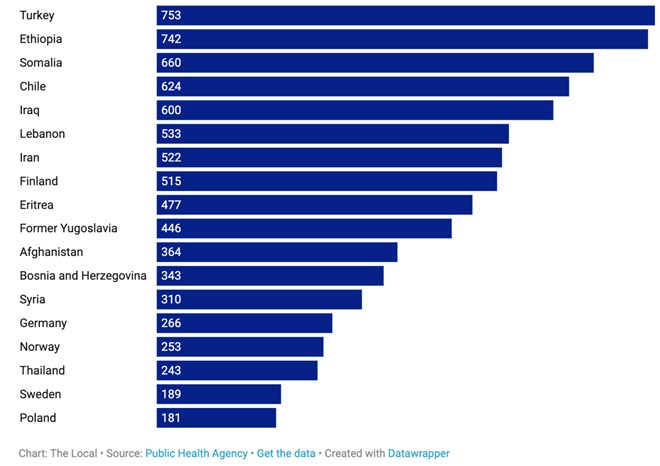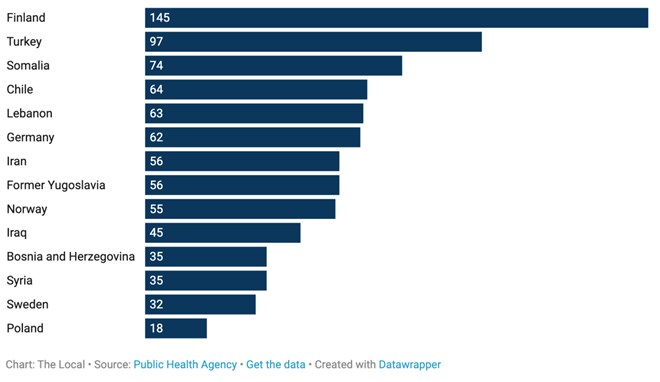People born overseas at higher risk from coronavirus in Sweden
People who were born overseas are at higher risk of both catching and dying from the coronavirus in Sweden, a new report from the Public Health Agency shows. But the figures can't tell us why the incidence and mortality rates are higher for the foreign-born population.
People who were born overseas are at higher risk of both catching and dying from the coronavirus in Sweden, a new report from the Public Health Agency shows. But the figures can’t tell us why the incidence and mortality rates are higher for the foreign-born population.
“We can clearly see that people with another country of birth than Sweden — almost any other country — have a greater risk of being affected by Covid-19,” state epidemiologist Anders Tegnell said at Thursday’s briefing with the Public Health Agency and other state agencies.
“Different groups have had high numbers of cases at different times. This is another piece in the puzzle of understanding how the virus is spreading in Sweden.”
The aim of the report, which looked at those diagnosed with coronavirus between March 13th and May 7th, was to direct resources where most needed, and to help limit further spread of infection.
Public Health Agency figures on the number of people who were diagnosed with coronavirus and who died after testing positive were compared with Statistics Sweden figures on the size of different national groups in Sweden.
The group most likely to be infected with coronavirus in Sweden, according to these figures, was people born in Turkey. Among this group, there were 389 confirmed cases during the eight-week period which is equivalent to 753 per 100,000 people. That compares to 189 confirmed cases per 100,000 people in the Swedish-born population.
The next most affected groups when looking at confirmed cases were people born in Ethiopia (161 cases or 742 per 100,000 people), Somalia (463 cases or 660 per 100,000 people), Chile (175 cases or 624 per 100,000 people) and Iraq (876 total cases or 600 per 100,000 people).
But people from these countries were affected to different extents at different stages of the outbreak.
More cases were diagnosed among people born in Somalia at the start of the time period studied, something which doctors raised the alarm about early on, while most cases among Iraqi-born people were diagnosed later in the outbreak, for example, and the incidence rate among people born in Chile or Ethiopia has been relatively steady.
See how other birth countries compare in the chart below.
Coronavirus incidence rate in Sweden by country of birth
This chart shows the number of confirmed coronavirus cases in Sweden per 100,000 members of the population, based on country of birth.

The Public Health Agency also looked at mortality rates among the different groups.
These figures showed that the mortality rate was highest among people born in Finland (210 deaths, or 145 per 100,000 people), followed by Turkey (50 deaths, or 97 per 100,000 people), Somalia (52 deaths or 74 per 100,000 people), Chile (18 deaths or 64 per 100,000 people), and Lebanon (18 deaths or 63 per 100,000 people).
Coronavirus mortality rate in Sweden by country of birth
Number of deaths with coronavirus per 100,000 members of the population.

This compared to 32 deaths per 100,000 people among those born in Sweden.
The report did not outline any possible explanation for these results.
But the agency did state that several factors are likely to impact the risk of catching and dying from the coronavirus, which this report did not take into account, including lifestyle factors, underlying diseases, and structural factors such as access to healthcare.
Lifestyle factors could include things like living in more crowded housing, a higher proportion of the group working in jobs that require social contact and cannot be done from home, or living in the parts of Sweden that have been worst hit by the virus, such as Stockholm.
How were these statistics compiled?
The start date of March 13th was chosen because this was the date when testing guidelines changed to state that all those with symptoms and in need of hospital care should be tested. Previously, the focus had been on people who had travelled to known high-risk areas.
The figures for confirmed cases are based on the Public Health Agency figures, which include those whose coronavirus diagnosis was confirmed by a laboratory test. The figures for deaths with coronavirus were based on deaths where the person had tested positive for the coronavirus in the past 30 days.
These two datasets were then compared with Statistics Sweden figures from 2019 on how many people are registered in Sweden from each country of birth, to work out how many cases or deaths took place in each group per 100,000 people in Sweden.
The report shows the countries of birth where more than 100 people tested positive for the coronavirus in Sweden, and/or where 11 or more people died of the coronavirus.




